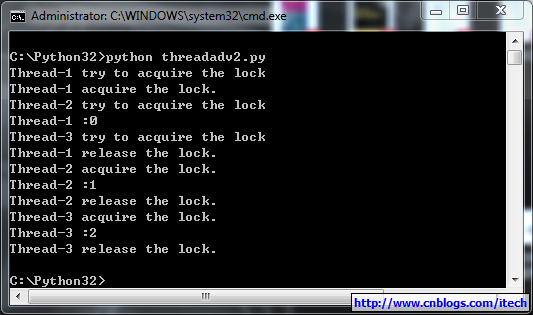Python多线程同步Lock、RLock、Semaphore、Event实例
一、多线程同步
由于CPython的python解释器在单线程模式下执行,所以导致python的多线程在很多的时候并不能很好地发挥多核cpu的资源。大部分情况都推荐使用多进程。
python的多线程的同步与其他语言基本相同,主要包含:
Lock & RLock :用来确保多线程多共享资源的访问。
Semaphore : 用来确保一定资源多线程访问时的上限,例如资源池。
Event : 是最简单的线程间通信的方式,一个线程可以发送信号,其他的线程接收到信号后执行操作。
二、实例
1)Lock & RLock
Lock对象的状态可以为locked和unlocked
使用acquire()设置为locked状态;
使用release()设置为unlocked状态。
如果当前的状态为unlocked,则acquire()会将状态改为locked然后立即返回。当状态为locked的时候,acquire()将被阻塞直到另一个线程中调用release()来将状态改为unlocked,然后acquire()才可以再次将状态置为locked。
Lock.acquire(blocking=True, timeout=-1),blocking参数表示是否阻塞当前线程等待,timeout表示阻塞时的等待时间 。如果成功地获得lock,则acquire()函数返回True,否则返回False,timeout超时时如果还没有获得lock仍然返回False。
实例:(确保只有一个线程可以访问共享资源)
复制代码 代码如下:
import threading
import time
num = 0
lock = threading.Lock()
def func(st):
global num
print (threading.currentThread().getName() + ' try to acquire the lock')
if lock.acquire():
print (threading.currentThread().getName() + ' acquire the lock.' )
print (threading.currentThread().getName() +" :%s" % str(num) )
num += 1
time.sleep(st)
print (threading.currentThread().getName() + ' release the lock.' )
lock.release()
t1 = threading.Thread(target=func, args=(8,))
t2 = threading.Thread(target=func, args=(4,))
t3 = threading.Thread(target=func, args=(2,))
t1.start()
t2.start()
t3.start()
结果:

RLock与Lock的区别是:RLock中除了状态locked和unlocked外还记录了当前lock的owner和递归层数,使得RLock可以被同一个线程多次acquire()。
2)Semaphore
Semaphore管理一个内置的计数器,
每当调用acquire()时内置计数器-1;
调用release() 时内置计数器+1;
计数器不能小于0;当计数器为0时,acquire()将阻塞线程直到其他线程调用release()。
实例:(同时只有2个线程可以获得semaphore,即可以限制最大连接数为2):
复制代码 代码如下:
import threading
import time
semaphore = threading.Semaphore(2)
def func():
if semaphore.acquire():
for i in range(5):
print (threading.currentThread().getName() + ' get semaphore')
semaphore.release()
print (threading.currentThread().getName() + ' release semaphore')
for i in range(4):
t1 = threading.Thread(target=func)
t1.start()